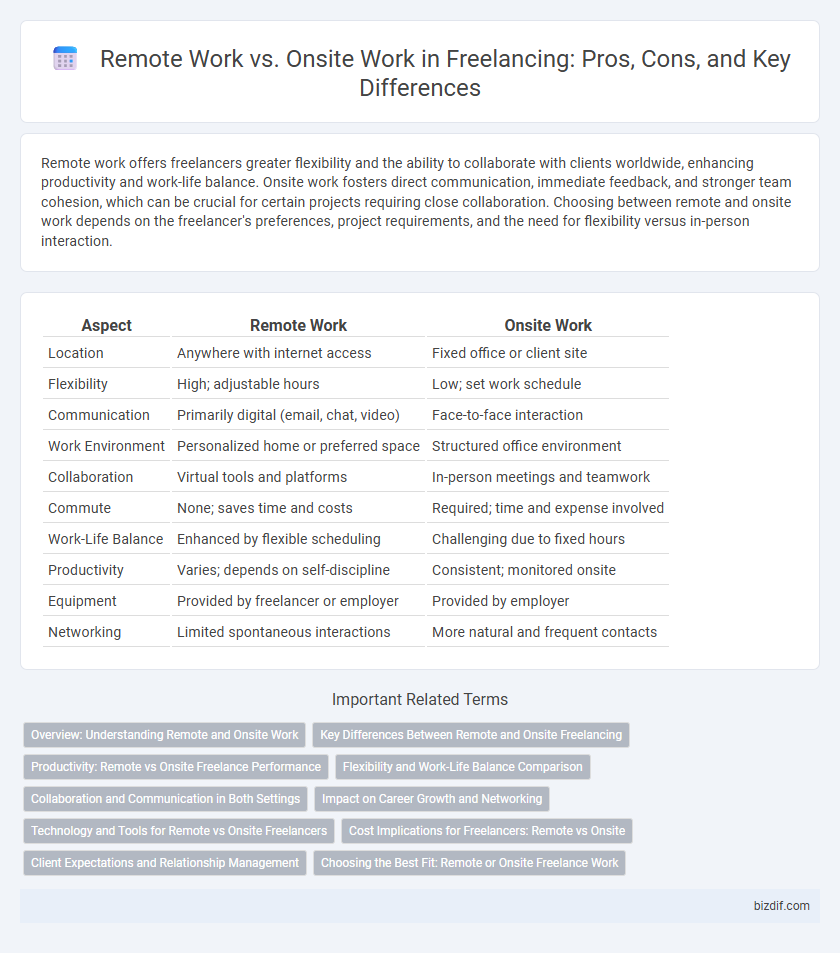Remote work offers freelancers greater flexibility and the ability to collaborate with clients worldwide, enhancing productivity and work-life balance. Onsite work fosters direct communication, immediate feedback, and stronger team cohesion, which can be crucial for certain projects requiring close collaboration. Choosing between remote and onsite work depends on the freelancer's preferences, project requirements, and the need for flexibility versus in-person interaction.
Table of Comparison
| Aspect | Remote Work | Onsite Work |
|---|---|---|
| Location | Anywhere with internet access | Fixed office or client site |
| Flexibility | High; adjustable hours | Low; set work schedule |
| Communication | Primarily digital (email, chat, video) | Face-to-face interaction |
| Work Environment | Personalized home or preferred space | Structured office environment |
| Collaboration | Virtual tools and platforms | In-person meetings and teamwork |
| Commute | None; saves time and costs | Required; time and expense involved |
| Work-Life Balance | Enhanced by flexible scheduling | Challenging due to fixed hours |
| Productivity | Varies; depends on self-discipline | Consistent; monitored onsite |
| Equipment | Provided by freelancer or employer | Provided by employer |
| Networking | Limited spontaneous interactions | More natural and frequent contacts |
Overview: Understanding Remote and Onsite Work
Remote work allows freelancers to operate from any location, leveraging digital communication tools to collaborate and deliver projects efficiently. Onsite work requires physical presence at the client's location, facilitating direct interaction and immediate feedback but limiting flexibility. Understanding the distinctions helps freelancers choose the best setting for productivity, work-life balance, and project requirements.
Key Differences Between Remote and Onsite Freelancing
Remote freelancing offers flexibility in work hours and location, enabling freelancers to collaborate with clients globally through digital tools. Onsite freelancing requires physical presence, fostering direct interaction and immediate feedback but limiting geographic scope. Key differences include communication style, work environment, and client engagement, impacting productivity and project management.
Productivity: Remote vs Onsite Freelance Performance
Remote freelance work often boosts productivity by minimizing commute time and allowing freelancers to create personalized work environments tailored to their optimal focus. Onsite freelance roles provide structured settings and immediate access to team collaboration, which can enhance productivity for tasks requiring direct communication. Studies show remote freelancers report higher efficiency in task completion, while onsite freelancers benefit from reduced distractions in professional environments.
Flexibility and Work-Life Balance Comparison
Remote work in freelancing offers unmatched flexibility, allowing professionals to design their schedules around personal commitments, which significantly enhances work-life balance. Onsite work often requires fixed hours and commuting, reducing time available for family and self-care activities. Studies show freelancers working remotely report 30% higher satisfaction in balancing work and personal life compared to onsite counterparts.
Collaboration and Communication in Both Settings
Remote work leverages digital tools such as Slack, Zoom, and Microsoft Teams to facilitate real-time collaboration and maintain seamless communication across time zones. Onsite work fosters spontaneous interactions and face-to-face meetings, enhancing team cohesion and immediate feedback. Effective collaboration in both remote and onsite settings relies on clear communication protocols, regular check-ins, and a strong organizational culture to ensure project alignment and productivity.
Impact on Career Growth and Networking
Remote work offers freelancers flexibility and access to a global client base, accelerating skill development and diverse project experience, which can enhance career growth. Onsite work provides direct interaction and relationship-building opportunities, fostering stronger professional networks and mentorship that are crucial for long-term career advancement. Balancing remote and onsite opportunities can optimize both skill acquisition and networking, maximizing freelance career potential.
Technology and Tools for Remote vs Onsite Freelancers
Remote freelancers leverage cloud-based platforms, collaboration tools like Slack and Zoom, and project management software such as Asana to maintain seamless communication and productivity. Onsite freelancers often rely on localized hardware setups, face-to-face interactions, and physical resources that enhance real-time problem-solving and teamwork. Advances in AI-driven software and high-speed internet significantly bridge the efficiency gap between remote and onsite freelancing environments.
Cost Implications for Freelancers: Remote vs Onsite
Remote work reduces overhead costs for freelancers by eliminating commuting expenses, office attire, and daily meals outside the home, while onsite work often incurs higher transportation and meal costs. Freelancers working onsite may need to invest in professional wardrobe and allocate time for travel, impacting both budget and productivity. Additionally, remote work offers flexibility to choose affordable work environments, optimizing overall cost efficiency in freelancing.
Client Expectations and Relationship Management
Clients often expect remote freelancers to demonstrate strong communication skills and reliability to build trust without face-to-face interaction. Onsite work allows for more immediate feedback and relationship-building through personal presence, fostering stronger rapport and collaboration. Effective relationship management in freelancing hinges on understanding these dynamics and consistently meeting client expectations regardless of work location.
Choosing the Best Fit: Remote or Onsite Freelance Work
Choosing between remote and onsite freelance work depends on individual productivity preferences and project requirements. Remote freelancing offers flexibility and access to global clients, enhancing work-life balance, while onsite freelancing provides direct collaboration and immediate feedback, fostering stronger client relationships. Evaluating factors like communication style, job complexity, and work environment will help freelancers select the best fit for maximizing efficiency and job satisfaction.
Remote Work vs Onsite Work Infographic

 bizdif.com
bizdif.com